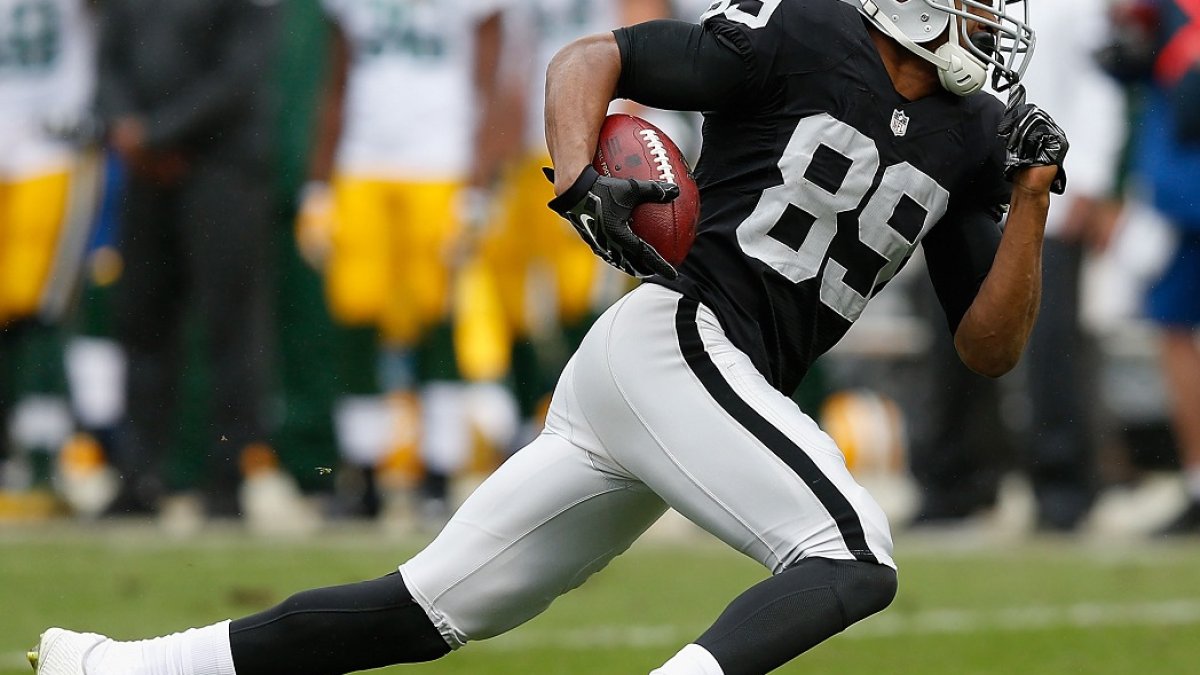(Editor’s note: As we lead up to the season, Director of PFF Fantasy Jeff Ratcliffe is breaking down each team’s depth chart from a fantasy perspective. Catch up on the work so far here.)
With ascending skill position talent and one of the league’s best offensive lines, the Raiders are a team rife with fantasy potential. That potential starts at the top with former-second rounder Derek Carr under center.
In 11 years as a pro, former No. 1 overall pick David Carr threw 65 touchdown passes. His younger brother Derek had nearly half that in his second professional season. After struggling in his rookie year, the younger Carr proved to be a revelation for the Raiders in Year 2, topping the 30-touchdown plateau and coming just 13 yards short of a 4,000-yard season. His 32 touchdown strikes is the second-most for a single season in Raiders history – Daryle Lamonica threw 34 in 1969. Carr completed just 61.1 percent of passes, but a closer look shows this number was due in part to his receivers dropping a league-high 44 passes. While Carr is due for some touchdown regression, the Raiders are trending in a positive direction and Carr is a strong candidate to repeat his front-end QB2 production from last season.
At receiver, the Raiders have a revitalized veteran in Michael Crabtree and a rising second-year man in Amari Cooper. One of the most polished receivers to enter the league in the last several seasons, Cooper stepped right into the Raiders’ offense and hit the ground running. He led all rookie receivers in fantasy points, finishing 23rd overall at the position. He also accomplished the rare feat of topping 1,000 yards in his first professional season. But things weren’t all good for Cooper, as he dropped a position-high 18 passes. Still, Cooper is a good bet to take a step forward in 2016, which means top-10 fantasy production is certainly not out of the question.
Oakland Raiders projected 2016 offense with 2015 grades:
Crabtree was largely written off for dead in fantasy circles, but he revived his career last season and finished as fantasy’s No. 20 wide receiver. Interestingly, it was Crabtree and not Cooper who functioned as the Raiders’ primary red zone receiver. He also saw 24 deep ball targets, which was seven more than Cooper. On those targets, Crabtree scored five of his nine touchdowns. Little has changed on the offensive side of the ball in Oakland this offseason, and Crabtree remains locked in as the starter opposite Cooper. We do expect Cooper to take a step forward in his second year, but there still should be plenty of targets for Crabtree. It may be a bit lofty to expect him to repeat as a WR2, but he squarely in the WR3 conversation.
Seth Roberts is the favorite to round out 3-wide sets, with Andre Holmes also in the mix. Neither figures to be off much fantasy value, but TE Clive Walford has the potential to be one of this year’s breakout players. He flashed down the stretch, scoring twice over the last three weeks of the season. Walford only saw 49 targets on the season, but he was one of just 10 tight ends to post an average depth of target over 10 yards. It should be noted that Walford did sustain a lacerated knee an offseason ATV accident. However, he’s running and is expected to be eased into camp. Walford makes for an upside TE2 option.
Few running backs were more heavily used than Latavius Murray was last season. The heavy volume helped him finished the year as fantasy’s No. 10 back. He also tied for third in forced missed tackles with 56, and had 12 carries of 15-plus yards for 320 total yards. Murray was also very involved as a receiver with 276 routes run, though he posted a disappointing 0.84 yards per route run, which was fourth fewest in the league. On the surface, it would seem that Murray has strong fantasy appeal. He’s a rare every-down player who has a jaw dropping size/speed profile. Yet, rumblings throughout offseason suggested the Raiders weren’t entirely sold on Murray.
[Where will Cooper go in drafts in his second season in the league? Check out our PFF Draft Master tool and try a mock draft, complete with offensive line grades, full projections and all the PFF data.]
This was somewhat confirmed with the draft day selection of DeAndre Washington, who is a smaller, bowling-ball type (5’8, 204), who posted 1,492 yards and 14 scores on 233 totes at Texas Tech last season. He also caught 41 balls for 385 yards and two scores. Washington flashed speed (4.49 40 time) and agility (7.03 3-cone drill) at the combine, and ranked third in this year's class in PFF elusive rating with 67 missed tackles caused. Murray is still the lead dog in the Oakland backfield and should be considered a back-end RB2, but Washington has the potential to steal touches. He offers sleeper appeal in the late rounds of drafts.
On the defensive side of the ball, the Raiders have one of the league’s best edge rushers in Khalil Mack. Unfortunately, due to the fantasy industry’s antiquated designation system, Mack remains a linebacker on many league commissioner sites. As such, Mack is either an elite fantasy defensive lineman, or a back-end LB2. At off-ball linebacker, Malcolm Smith quietly finished as an LB1 last season. He’s best considered an LB2, but Smith certainly has the potential for another top-10 finish. Rookie Karl Joseph has recovered well from a torn ACL and is on track for Week 1. He offers an intriguing fantasy profile as a heavy hitter and makes for the better IDP option over Raiders FS Reggie Nelson.




 © 2025 PFF - all rights reserved.
© 2025 PFF - all rights reserved.